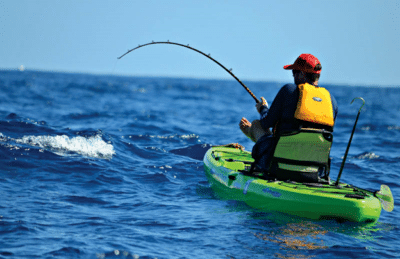Fishing for sharks from a kayak can be one of the most exciting forms of fishing that you will ever do.
Hooking into a shark from a small plastic kayak can be a massive adrenaline rush, but there are a few important safety concerns to be aware of if it is your first time out.
Sharks are large apex predators and the can put up one hell of a fight especially when you are not on a stable platform like the beach or a charter boat.
But, this can also pose a serious risk to your safety.
Maintaining your balance and remaining upright on the kayak is the most important thing when kayak shark fishing
That being said if you are careful it is just as safe as being in a boat.
Techniques, tactics and gear will be similar to inshore shark fishing from a boat. From a kayak however you do have access to a lot more of the coast line from rocky bays to shallow flats.
Kayak Shark Fishing
Shark fishing from a kayak will generally be done using a couple of rods all of which will be using some form of bait.
Although you can troll from your kayak the most successful method will to use a strong scented bait. The best shark baits will normally some form of freshly caught local fish.
Local is best as it is what the sharks are already used to feeding on.
Personally I would not use a chum bag when sharking on a kayak as it poses a risk of capsizing.
If you have a chum bag attached to your kayak and a larger shark decides to bite it and try and run with it you may well end up be turn over and into the water.
By all means have a small bucket of chum and throw it in occasionally to help attract sharks in from a distance but do not tie off a chum bag to your kayak unless you have some form of reliable quick release system.
Tackle Considerations
When fishing from a kayak I would tend to use slightly lighter shark fishing tackle than normal.
The reason for this is that you want a really large shark to be able to break the line as a big shark can easily flip you over if they strike your bait hard.
You should also never use a heavy drag as a light drag will lessen the impact of them striking.
Keep your line tight so you can sense every little bump or bite. I would run 20 to 30 lbs main line and of course a wire leader is essential when fishing for sharks.
You won’t really be casting any great distance so any shark fishing rod that is suitable for boat fishing should be good enough.
I would avoid roller line guides in favor of more traditional rind guides for your rod as roller guides can be trouble if the line is continually slipping the roller and getting caught on the assembly.
The best reel for shark fishing from a kayak will be either a large capacity spinning reel or a conventional reel.
Conventional reels are simple and very reliable a Penn Senator for example can be picked up pretty cheaply these days and if properly maintained should last a lifetime.
If a spinning setup is your preference then a size 5000 and up should be good for lighter shark work.
Once Hooked
Once you have a shark on the line probably the most stressful time will be playing it out and then the final unhooking.
Also Read: Difference Between Great White vs Bull Sharks
The majority of shark fishing is catch and release only so the quicker you play the shark the better the chances of it having enough energy to swim away safely afterwards.
Always keep the bow of the kayak pointed towards the shark as this will help keep you balanced.
You now need to decide will you land the shark on a beach which is safer or continue to play it out on the water.
Extreme care should be taken when unhooking and you should use a very long nose pliers. Never ever put your hand or fingers near the sharks mouth.
Kayak Safety
Firstly, you should receive proper training on how to safely use your kayak.
Secondly make sure you know and understand the currents in the area that you intend on fishing in.
Tides can be very powerful and paddling against a strong outgoing tide can be next to near impossible.
Paddling in the open water is a very dangerous activity and you really should spend some time with an experienced kayak-er learning all of the necessary safety drills and understanding safety equipment.
A personal flotation device(PFD) is an essential item. In the event of a capsize it is your life line and will help keep you upright in the water.
A first aid kit and a helmet are also important. Safety flares and a two way radio are also a good option.

